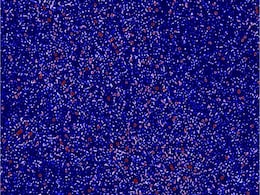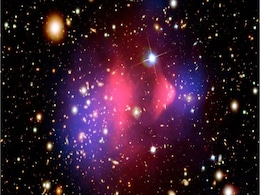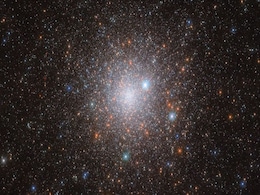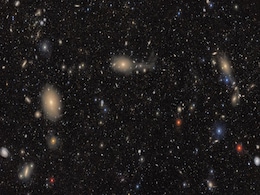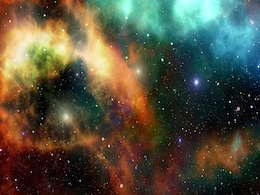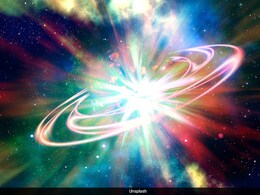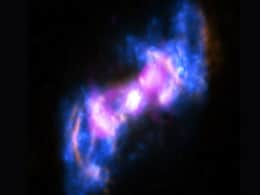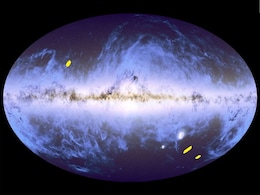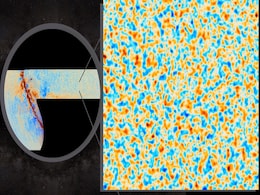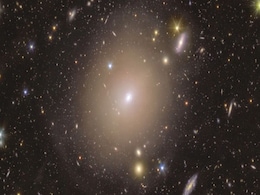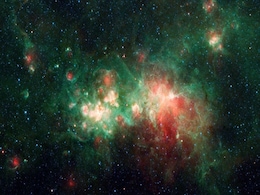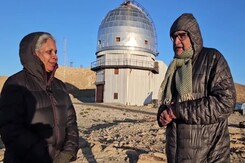Dark Universe Telescope
- All
- News
- Videos
-

Scientists Create Most Detailed Radio Map of Early Universe Using MWA
- Saturday October 18, 2025
- Written by Gadgets 360 Staff
Scientists using the Murchison Widefield Array in Australia analyzed nine years of radio data to study the elusive 21-cm hydrogen signal from the universe’s dark ages. Their findings suggest early black holes and stars had already heated cosmic gas, marking the first observational evidence of this warming phase.
-
 www.gadgets360.com
www.gadgets360.com
-

Dark Matter Might Leave A Faint Colour Mark In Light, Say Scientists
- Thursday October 16, 2025
- Written by Gadgets 360 Staff
Dark matter, though invisible, might subtly alter the colour of light passing through it, according to a new University of York study. Researchers propose that weak particle interactions could create faint red or blue tints, offering a new path for future telescopes to detect dark matter indirectly.
-
 www.gadgets360.com
www.gadgets360.com
-

Hubble Unveils Dark Matter Web in Stunning Abell 209 Galaxy Cluster Image
- Sunday July 20, 2025
- Written by Gadgets 360 Staff
NASA/ESA’s Hubble Space Telescope has released a stunning new image of Abell 209, a massive galaxy cluster 2.8 billion light-years away in Cetus. The golden cluster houses over 100 galaxies, but beneath them lies an invisible web of hot gas and dark matter. Using gravitational lensing, Hubble reveals curved arcs of light from background galaxies,...
-
 www.gadgets360.com
www.gadgets360.com
-

Vera C. Rubin Observatory Unveils First Images, Hints at Universe’s Dynamic Secrets Ahead
- Wednesday June 25, 2025
- Written by Gadgets 360 Staff
The Rubin Observatory’s first image captures 10 million galaxies, marking the start of a decade-long sky survey. With its powerful telescope and LSST camera, it will scan the southern sky every three nights, unveiling hidden galaxies, stellar nurseries, and transient cosmic events. Scientists anticipate transformative discoveries about dark matte...
-
 www.gadgets360.com
www.gadgets360.com
-

Radio Signal from Early Universe May Reveal the Masses of the First Stars
- Sunday June 22, 2025
- Written by Gadgets 360 Staff
A newly modelled 21-centimetre radio signal from hydrogen atoms just 100 million years after the Big Bang may reveal the mass of the universe’s first stars. Using REACH and the upcoming SKA telescopes, researchers aim to uncover how early starlight shaped cosmic evolution during the Cosmic Dawn, when the universe transitioned from darkness to lig...
-
 www.gadgets360.com
www.gadgets360.com
-

Scientists Observe Light Of "Cosmic Dawn" With Telescope On Earth For The First Time Ever
- Thursday June 12, 2025
- Science | Edited by Srishti Singh Sisodia
Cosmic dawn insights shed light on the universe's early stages, providing an understanding of the universe's origins.
-
 www.ndtv.com
www.ndtv.com
-

The Universe’s Brightest Lights Have Surprisingly Dark and Mysterious Origins
- Saturday May 3, 2025
- Written by Gadgets 360 Staff
NASA’s Fermi Gamma-ray Space Telescope has revealed that some of the universe’s brightest light sources originate near supermassive black holes in galaxy centres. These active galactic nuclei emit intense radiation, including gamma rays and X-rays, despite black holes themselves being invisible. Their powerful jets and high-energy emissions cha...
-
 www.gadgets360.com
www.gadgets360.com
-

ESA’s Euclid Telescope Releases First Data, Mapping 26 Million Galaxies
- Wednesday March 26, 2025
- Written by Gadgets 360 Staff
ESA’s Euclid telescope has released its first dataset, mapping 26 million galaxies within a week. The observations include deep-field images, a survey of 380,000 galaxies, and 500 new gravitational lens candidates. Scientists will continue tracking cosmic evolution over six years. The dataset, currently 35 terabytes, is expected to grow to 2 peta...
-
 www.gadgets360.com
www.gadgets360.com
-

What Is Dark Energy? The Mystery Behind The Expanding Universe
- Thursday March 20, 2025
- World News | Agence France-Presse
Dark energy makes up roughly 70 percent of the universe, yet we know nothing about it. Around 25 percent of the universe is the equally mysterious dark matter, leaving just five percent for everything that we can see and touch.
-
 www.ndtv.com
www.ndtv.com
-

Europe's 'Dark Universe Detective' Telescope, Launched In 2023, Releases 1st Data
- Wednesday March 19, 2025
- World News | Agence France-Presse
The telescope launched in 2023, aiming to chart one third of the sky -- encompassing 1.5 billion galaxies -- to create what has been billed as humanity's most accurate 3D map of the universe.
-
 www.ndtv.com
www.ndtv.com
-

Atacama Telescope Reveals Most Detailed Cosmic Microwave Background Yet
- Thursday March 20, 2025
- Written by Gadgets 360 Staff
New images from the decommissioned Atacama Cosmology Telescope offer the most detailed view of the cosmic microwave background. The data reveals early cosmic structures, tracks primordial gas movement, and refines estimates of the universe’s total mass. While supporting existing models, it does not resolve the Hubble tension. Researchers are now ...
-
 www.gadgets360.com
www.gadgets360.com
-

Euclid Space Telescope Discovers Rare Einstein Ring, Revealing Dark Matter Secrets
- Wednesday February 12, 2025
- Written by Gadgets 360 Staff
The Euclid space telescope has detected a rare Einstein ring around galaxy NGC 6505, located approximately 590 million light-years from Earth. This phenomenon, resulting from gravitational lensing, allows scientists to study the distribution of dark matter within the lensing galaxy. The discovery aligns with Euclid's mission to map cosmic structure...
-
 www.gadgets360.com
www.gadgets360.com
-

New Cosmic Surveys Reveal Unexpected Clues About Universe’s Evolution
- Monday February 3, 2025
- Written by Gadgets 360 Staff
A new study published in the Journal of Cosmology and Astroparticle Physics reveals a potential discrepancy in the expected clumpiness of cosmic structures. Researchers from the University of Pennsylvania and Lawrence Berkeley National Laboratory analysed data from the Atacama Cosmology Telescope (ACT) and the Dark Energy Spectroscopic Instrument (...
-
 www.gadgets360.com
www.gadgets360.com
-

Coma Cluster’s Distance Closer Than Predicted, Amplifying Hubble Tension Crisis
- Friday January 24, 2025
- Written by Gadgets 360 Staff
A new study led by Dan Scolnic and Adam Riess reveals that the Coma Cluster is 38 million light-years closer than predicted by standard cosmological models, intensifying the ongoing Hubble tension. This discrepancy, involving measurements of type Ia supernova explosions, challenges the universe's expansion rate as predicted by the Hubble–Lemaîtr...
-
 www.gadgets360.com
www.gadgets360.com
-

New Study Uncovers Discrepancies in Universe’s Expansion Rate, Challenges Cosmology Models
- Wednesday January 22, 2025
- Written by Gadgets 360 Staff
A recent study has revealed inconsistencies in the universe's expansion rate, further challenging established cosmological models. Measurements from the Hubble Space Telescope, James Webb Space Telescope, and the Dark Energy Spectroscopic Instrument (DESI) indicate that the universe is expanding at varying speeds. This discrepancy raises critical q...
-
 www.gadgets360.com
www.gadgets360.com
-

Scientists Create Most Detailed Radio Map of Early Universe Using MWA
- Saturday October 18, 2025
- Written by Gadgets 360 Staff
Scientists using the Murchison Widefield Array in Australia analyzed nine years of radio data to study the elusive 21-cm hydrogen signal from the universe’s dark ages. Their findings suggest early black holes and stars had already heated cosmic gas, marking the first observational evidence of this warming phase.
-
 www.gadgets360.com
www.gadgets360.com
-

Dark Matter Might Leave A Faint Colour Mark In Light, Say Scientists
- Thursday October 16, 2025
- Written by Gadgets 360 Staff
Dark matter, though invisible, might subtly alter the colour of light passing through it, according to a new University of York study. Researchers propose that weak particle interactions could create faint red or blue tints, offering a new path for future telescopes to detect dark matter indirectly.
-
 www.gadgets360.com
www.gadgets360.com
-

Hubble Unveils Dark Matter Web in Stunning Abell 209 Galaxy Cluster Image
- Sunday July 20, 2025
- Written by Gadgets 360 Staff
NASA/ESA’s Hubble Space Telescope has released a stunning new image of Abell 209, a massive galaxy cluster 2.8 billion light-years away in Cetus. The golden cluster houses over 100 galaxies, but beneath them lies an invisible web of hot gas and dark matter. Using gravitational lensing, Hubble reveals curved arcs of light from background galaxies,...
-
 www.gadgets360.com
www.gadgets360.com
-

Vera C. Rubin Observatory Unveils First Images, Hints at Universe’s Dynamic Secrets Ahead
- Wednesday June 25, 2025
- Written by Gadgets 360 Staff
The Rubin Observatory’s first image captures 10 million galaxies, marking the start of a decade-long sky survey. With its powerful telescope and LSST camera, it will scan the southern sky every three nights, unveiling hidden galaxies, stellar nurseries, and transient cosmic events. Scientists anticipate transformative discoveries about dark matte...
-
 www.gadgets360.com
www.gadgets360.com
-

Radio Signal from Early Universe May Reveal the Masses of the First Stars
- Sunday June 22, 2025
- Written by Gadgets 360 Staff
A newly modelled 21-centimetre radio signal from hydrogen atoms just 100 million years after the Big Bang may reveal the mass of the universe’s first stars. Using REACH and the upcoming SKA telescopes, researchers aim to uncover how early starlight shaped cosmic evolution during the Cosmic Dawn, when the universe transitioned from darkness to lig...
-
 www.gadgets360.com
www.gadgets360.com
-

Scientists Observe Light Of "Cosmic Dawn" With Telescope On Earth For The First Time Ever
- Thursday June 12, 2025
- Science | Edited by Srishti Singh Sisodia
Cosmic dawn insights shed light on the universe's early stages, providing an understanding of the universe's origins.
-
 www.ndtv.com
www.ndtv.com
-

The Universe’s Brightest Lights Have Surprisingly Dark and Mysterious Origins
- Saturday May 3, 2025
- Written by Gadgets 360 Staff
NASA’s Fermi Gamma-ray Space Telescope has revealed that some of the universe’s brightest light sources originate near supermassive black holes in galaxy centres. These active galactic nuclei emit intense radiation, including gamma rays and X-rays, despite black holes themselves being invisible. Their powerful jets and high-energy emissions cha...
-
 www.gadgets360.com
www.gadgets360.com
-

ESA’s Euclid Telescope Releases First Data, Mapping 26 Million Galaxies
- Wednesday March 26, 2025
- Written by Gadgets 360 Staff
ESA’s Euclid telescope has released its first dataset, mapping 26 million galaxies within a week. The observations include deep-field images, a survey of 380,000 galaxies, and 500 new gravitational lens candidates. Scientists will continue tracking cosmic evolution over six years. The dataset, currently 35 terabytes, is expected to grow to 2 peta...
-
 www.gadgets360.com
www.gadgets360.com
-

What Is Dark Energy? The Mystery Behind The Expanding Universe
- Thursday March 20, 2025
- World News | Agence France-Presse
Dark energy makes up roughly 70 percent of the universe, yet we know nothing about it. Around 25 percent of the universe is the equally mysterious dark matter, leaving just five percent for everything that we can see and touch.
-
 www.ndtv.com
www.ndtv.com
-

Europe's 'Dark Universe Detective' Telescope, Launched In 2023, Releases 1st Data
- Wednesday March 19, 2025
- World News | Agence France-Presse
The telescope launched in 2023, aiming to chart one third of the sky -- encompassing 1.5 billion galaxies -- to create what has been billed as humanity's most accurate 3D map of the universe.
-
 www.ndtv.com
www.ndtv.com
-

Atacama Telescope Reveals Most Detailed Cosmic Microwave Background Yet
- Thursday March 20, 2025
- Written by Gadgets 360 Staff
New images from the decommissioned Atacama Cosmology Telescope offer the most detailed view of the cosmic microwave background. The data reveals early cosmic structures, tracks primordial gas movement, and refines estimates of the universe’s total mass. While supporting existing models, it does not resolve the Hubble tension. Researchers are now ...
-
 www.gadgets360.com
www.gadgets360.com
-

Euclid Space Telescope Discovers Rare Einstein Ring, Revealing Dark Matter Secrets
- Wednesday February 12, 2025
- Written by Gadgets 360 Staff
The Euclid space telescope has detected a rare Einstein ring around galaxy NGC 6505, located approximately 590 million light-years from Earth. This phenomenon, resulting from gravitational lensing, allows scientists to study the distribution of dark matter within the lensing galaxy. The discovery aligns with Euclid's mission to map cosmic structure...
-
 www.gadgets360.com
www.gadgets360.com
-

New Cosmic Surveys Reveal Unexpected Clues About Universe’s Evolution
- Monday February 3, 2025
- Written by Gadgets 360 Staff
A new study published in the Journal of Cosmology and Astroparticle Physics reveals a potential discrepancy in the expected clumpiness of cosmic structures. Researchers from the University of Pennsylvania and Lawrence Berkeley National Laboratory analysed data from the Atacama Cosmology Telescope (ACT) and the Dark Energy Spectroscopic Instrument (...
-
 www.gadgets360.com
www.gadgets360.com
-

Coma Cluster’s Distance Closer Than Predicted, Amplifying Hubble Tension Crisis
- Friday January 24, 2025
- Written by Gadgets 360 Staff
A new study led by Dan Scolnic and Adam Riess reveals that the Coma Cluster is 38 million light-years closer than predicted by standard cosmological models, intensifying the ongoing Hubble tension. This discrepancy, involving measurements of type Ia supernova explosions, challenges the universe's expansion rate as predicted by the Hubble–Lemaîtr...
-
 www.gadgets360.com
www.gadgets360.com
-

New Study Uncovers Discrepancies in Universe’s Expansion Rate, Challenges Cosmology Models
- Wednesday January 22, 2025
- Written by Gadgets 360 Staff
A recent study has revealed inconsistencies in the universe's expansion rate, further challenging established cosmological models. Measurements from the Hubble Space Telescope, James Webb Space Telescope, and the Dark Energy Spectroscopic Instrument (DESI) indicate that the universe is expanding at varying speeds. This discrepancy raises critical q...
-
 www.gadgets360.com
www.gadgets360.com

